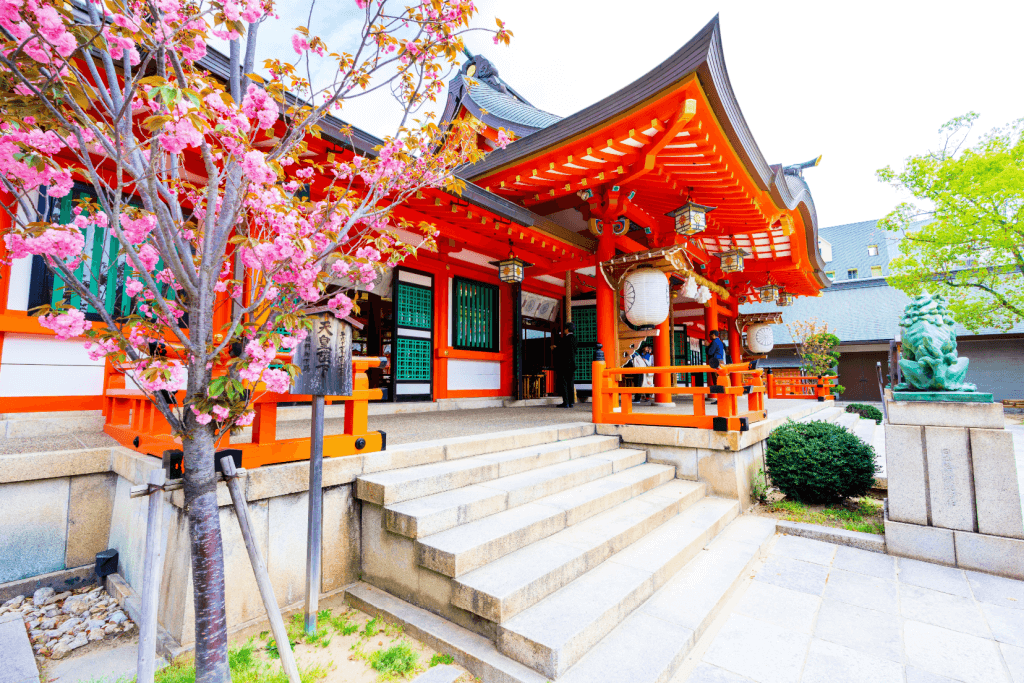love shrines
Hakone Shrine and Other Beautiful Love Shrines To See!
Thuy Fang
Posted on January 26, 2024
Share:

With their picturesque setting and cultural importance, love shrines like Hakone Shrine symbolize hope and devotion for those seeking romantic blessings in Japan. People here think that when they connect with the gods, it makes them happy and brings love into their lives. And these shrines are also unique and treasured in Japanese history. Join us in exploring the enchantment of love shrines, where faith and love intertwine.
Hakone Shrine (Hakone, Kanagawa Prefecture)
With a history spanning over 1200 years, Hakone Shrine is famous for its connection to dragons, samurai, and people journeying along the Tokaido Road. The shrine’s serene atmosphere is inviting and peaceful, surrounded by red lanterns and tall cedar trees. That makes it a must-visit destination.
The shrine first stood on Mount Hakone but then moved to Lake Ashi’s shores in 1667. According to legend, Priest Mangan had set up the shrine and calmed a nine-headed dragon in Lake Ashi. Nowadays, we can see the unique fountain that people believe brings good luck and love to celebrate this event.

Furthermore, this location is also a place of worship and remembrance for the talented Minamoto no Yoritomo (1147-1199), the founder of the Shogunate system. According to tales, Minamoto no Yoritomo went to Hakone for help after his defeat in the Battle of Ishibashiyama. Later, when he became a shogun, he supported the shrine.
Notably, the shrine enshrines three Great Gods of Hakone, each representing different aspects. The majestic Heiwa no Torii (Peace Torii Gate) at Hakone Shrine is among them. This historical site is by Lake Ashi’s shore, and many people consider it the most distinctive highlight. This red gate symbolizes the transition from ordinary to sacred and provides a pleasant view of the large lake. Climbing 89 steps behind, it takes you to the main shrine, where people pray for happiness, wealth, safety, and love.
In addition, Hakone Shrine always comes alive with exciting festivals. During Lake Ashinoko Summer Festival week, Shinto celebrations, rituals, and fantastic fireworks make the air feel magical. All in all, it’s a time of joy and wonder at Hakone Shrine!
Ikuta Shrine (Kobe, Hyogo Prefecture)
Ikuta Shrine is a fascinating Shinto sanctuary and possibly one of the oldest shrines in Japan. It was established by Empress Jingu over 1800 years ago to honor Watatsumi, a sea deity. She built the Ikuta Shrine after surviving a challenging journey, thanks to prayers to this god.
The shrine has a connection to historical events such as the Genpei War. The battle of Ichi-no-Tani made a mark in the forest near Ikuta Shrine. The Ikuta Autumn Festival is a highlight, featuring Noh plays that retell stories from the old Genpei War. These fantastic shows bring history and a festive vibe to the shrine.

Even though the modern city of Kobe has grown around it, the shrine still stands strong as a symbol of hope and strength. It endured many disasters like wars, earthquakes, and floods yet stayed strong. Ikuta Shrine is a vibrant place where people celebrate love and connections. The goddess Wakahirume-no-Mikoto worshipped at the shrine is associated with bringing people together.
Today, the shrine has become famous for couples seeking blessings for their relationships and marriages. Moreover, it’s crowded with many stalls lining the streets during the New Year festivities. Stalls are also set up within the shrine premises from December 31 to January 3.
Are you looking for some amazing snacks this Valentine’s Day? Check out Sakuraco! Sakuraco delivers traditional Japanese snacks, teas, and sweets from local Japanese makers directly to your door so you can enjoy the latest delicacies directly from Japan!
Izumo Taisha Shrine (Izumo, Shimane Prefecture)
Izumo Taisha, also known as Izumo Oyashiro, is one of Japan’s oldest and most significant Shinto shrines. This sacred site is dedicated to Okuninushi, the deity associated with marriage, relationships, and the creation of Japan. Izumo Taisha has been around since the early 700s. It has a long past with changes during the Kamakura period. Later on, it became a Kanpei-taisha (the most highly-ranked shrine) and got support from the government between 1871 and 1946.

Generally, the shrine undergoes a regular rebuilding process every 60 to 70 years, preserving kami power and architectural techniques. Some buildings in the shrine area are even recognized as Important Cultural Properties of Japan.
Also, festivals play a crucial role in Izumo’s cultural calendar. Celebrations like the Imperial Festival and Grand Festival in May and various exciting events in January, February, April, June, and August always attract locals and visitors. In the tenth month of the lunar calendar, there’s a whole month of gods gathering called Kamiarizuki, showing how the shrine is a big part of Japan’s spiritual stories.
Why should I visit spots like Hakone Shrine for Valentine’s Day?
Overall, going to love shrines like Hakone Shrine on Valentine’s Day is special. You’ll get to enjoy and understand the importance of love and relationships in Japan. The peaceful surroundings and traditions can create a lovely backdrop for celebrating love. These shrines are famous for their link to love and relationships.
As a result, their lively festivals also make them a favorite for people who want to experience culture and connect spiritually. Have you visited any of these love shrines or experienced similar traditions? Share your thoughts in the comments below!

Discover authentic flavors with Sakuraco
Get Sakuraco 

Discover authentic flavors with Sakuraco
Get Sakuraco 
Related Articles

Hatsumode: Why Is It Japan’s Most Important Tradition?
Hatsumode is the first visit to a shrine or temple in the New Year in Japan, and it is one of the country’s most important traditions. Every year, millions of people participate, demonstrating the profound connection between this custom and daily life.

Japanese Fish Bait: The Beautiful Art of Kebari
Kebari are traditional hand-tied flies used for freshwater fishing in Japan, especially in mountain streams where small insects form the main diet of native fish. Instead of bright plastic lures, kebari use feathers, thread, and natural materials to create subtle movements in the water.

Japan Holidays Guide: Relax, Explore, and Delight in Festive Fun
As the year draws to a close, everywhere buzzes with preparations for the holidays, and Japan is no exception. Despite the cold winter weather, you can feel warmth in the scenery, decorations, and festive activities across the country. Let’s explore the unique experiences of holidays in Japan that many people dream of enjoying at least once in their lifetime!

Tokyo Gardens: Five Beautiful Traditional Japanese Gardens to Visit
Tokyo gardens offer a relaxing escape for visitors looking to get a breath of fresh air. However, Tokyo has more than just the typical gardens we see in the West. Let’s explore five traditional Japanese gardens and what makes them unique!



